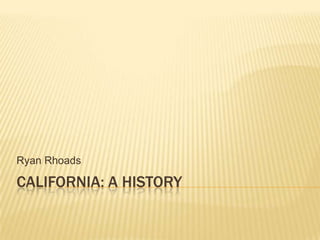
CALIFORNIA'S NATIVE PEOPLES AND EARLY EXPLORATION
- 1. CALIFORNIA: A HISTORY Ryan Rhoads
- 2. The Native People’s of California CH:1 With California’s landscape having so much to offer it is no surprise that at the time when Europeans first made contact with the land in 1492 that nearly one third of all Native Americans living within the present day continental U.S. likely around three hundred thousand, are estimated to have been living within the present day boundaries of California. Anthropologists describe the Native American culture as belonging to twenty-two linguistic families in which of these categories were some 135 separate languages. Located in the mountainous, stream-rich northwest were the fishing peoples: the Yuki, the Tolowa, Karok, and Yurok, the Hoopa, Wiyot, Mattole, and Wailaki. To the west were the people: the Wintun, the Shasta, and the Yana. To the coastal south were the Pomo, the Maidu, the Lile’ek, and the Wappo. Many tribes could also have been found in present day Orange county, San Francisco and just north of that in Marin county, San Joaquin Valley and to the east along the mountains and plains of San Bernardino.
- 3. Spanish Exploration CH:2 In 1513 a young adventurer named Vasco Nunez de Balboa led an expedition from the eastern edge of Panama into the interior. In September 1513 Balboa and his men made the discovery of the Pacific Ocean yet his discovery would remain unknown to the Spanish for a decade as Balboa had been fleeing creditors and was avoiding any contact that might send them his way. A Spanish sailing expedition led by Portuguese navigator Ferdinand Magellan had hoped to find a new quick path to the riches of the Indies. He set sail on September 20, 1519 with 5 vessels and 265 men. By January he had reached South America, rounded the tip of the continent and on November 28, 1520 he reached the Pacific Ocean. He continued on a northwest course reaching the Marianas on March 6, 1521, and the Philippines ten days later where he was killed on April 27, 1521 while trying to arbitrate a dispute between the natives. One of his ships continues on the journey to cross the Indian Ocean and reach Europe on September 6, 1522. Magellan’s expedition had successfully completed the first circumnavigation of the globe and linked Spain, the Atlantic, the Caribbean, South and Central America, and Mexico, the Pacific, and the Philippines “into a continuum that would hold its unity until the collapse of the Spanish empire in the early 1800s.” Located at the center of this continuum was Mexico from which the eventual exploration and settlement of California would be launched. Ferdinand Magellan
- 4. The Railroad CH:5 It had become National policy by the mid 1800s to extend the railroad across the continent linking the East to West Coast and by 1860 more than thirty thousand miles of track had been laid. It was in March of 1853 when congress directed for a commission to be set into place a report by the Topographical Corps of the U.S. Army to prepare a report recommending the five best routes for a transcontinental railroad line. A three volume survey titled Pacific Railroad Reports were presented in 1855. In California Oliver Wozencraft who was a member of the constitutional convention of 1849 and engineer by the name of Theodore Judah were separately on track to find a way to link the state of California with the rest of the continent via railroad. Theodore Judah traveled to Washington to lobby for federal support for the construction of the railway which would link the west coast with the rest of the nation. After months of failed attempts to win support for his cause he found a winning argument that it was paramount for the security of the nation for there to be a continental railroad linking the two coast in the event of an invasion of a foreign invader so that military forces could quickly and effectively reach the west coast to defend the territory. He also suggested that there was a possibility of dissension between the western territories that were so disconnected from the rest of the union and how would the rest of the nation get along without the gold, silver, and grain from the west.? Judah had gathered the support he needed and the pacific railway Act of 1862 was passed and in 1864 a second act was passed allotting more funds and land grants to the railway making the Central pacific and the Union Pacific the two largest landowners in the Far West. Theodore Judah